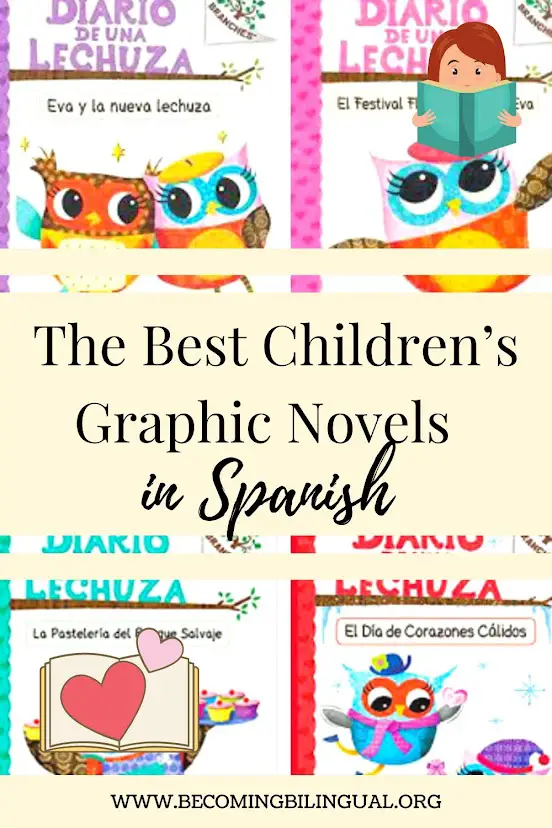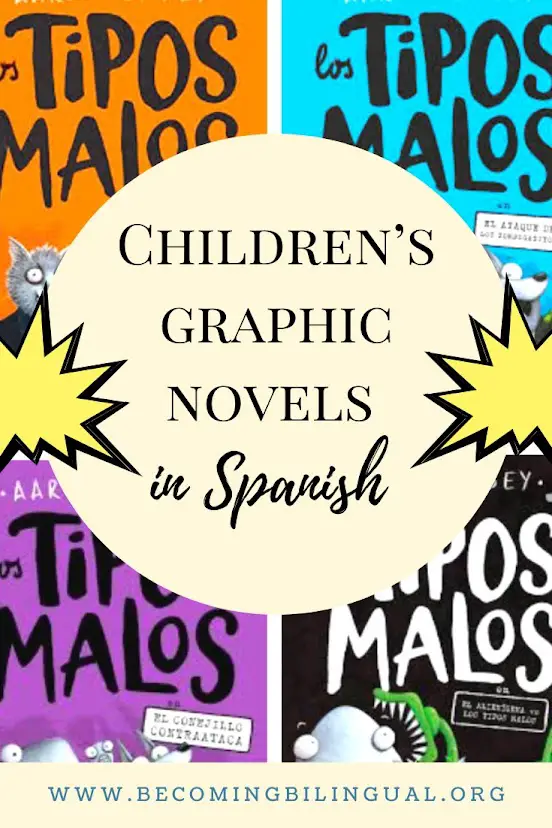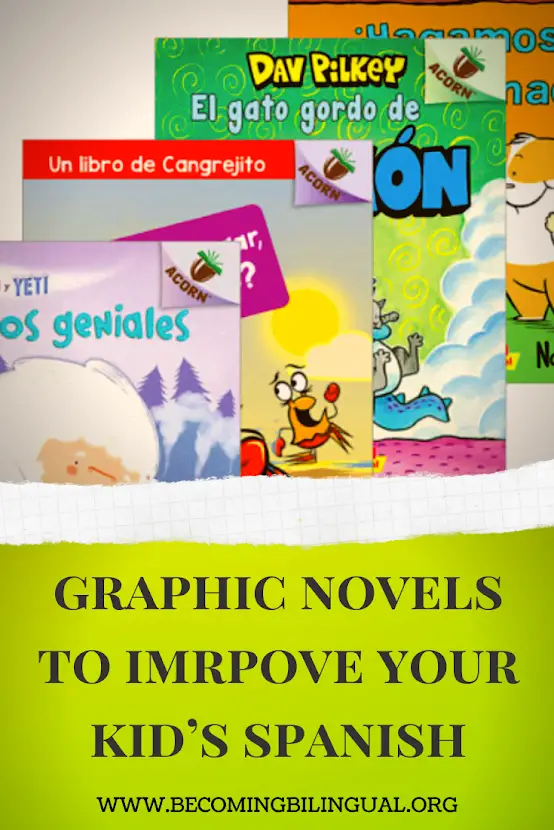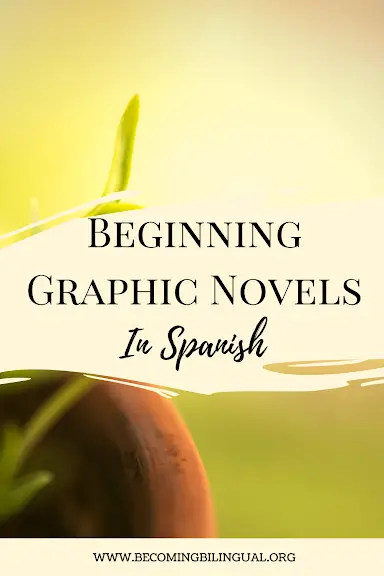Reading To Improve: Beginner Graphic Novels

When my daughter was almost three, we started reading beginning graphic novels in Spanish. Graphic novels are great for language learning for a variety of reasons and I was happy to find several good ones when I was looking for books for us to read together!
In this article I’ll share how you can use graphic novels to learn Spanish, which children’s graphic novels in Spanish are the best and the graphic novels in Spanish that we recommend.
The first graphic novels that I looked for were ones that were divided into chapters and that were relatively simple. My daughter had developed stamina for reading longer picture books and I wanted to transition her into reading chapter books.
Short graphic novels were a good way for us to transition to chapter books because they still had plenty of picture support, they had short chapters so that we could read a chapter each night in a relatively quick amount of time, and they had stories that were easy to follow through.
Looking for graphic novels for middle grade readers or adults? Check out these articles!
Middle Grade Graphic Novels in Spanish
This post contains affiliate links. If you click an affiliate link and make a purchase, I earn a small commission which supports this blog at no additional cost to you. Please see the Privacy Policy for details. Thank you for supporting me!

Table of Contents
Why Use Graphic Novels To Learn A Language?
Picture Support
Though my daughter spends a lot of time listening to audiobooks in the car, we hadn’t spent time reading physical books that didn’t have any pictures. Before I jumped right into chapter books, I wanted to work on longer texts that still had picture support.
The pictures in graphic novels are great because they show what is happening in each scene and provide plenty of context for what is happening in the story. While there may be inferring involved in more mature graphic novels, beginning graphic novels are fairly straight forward and don’t leave much to interpretation.
Graphic novels usually have bright colors and show action, so they are inherently engaging. I was relying on this engagement to help my daughter follow through each chapter without losing interest in the story.
Short Chapters
If you’ve read my post on chapter books in my “Reading To Improve” series, then you’ll know that some chapter books can have long chapters 12-15 pages! My daughter had stamina for longer pictures books, but not for a chapter that was 15 pages long.
The beginning graphic novels that we used had relatively short chapters. This was important to me because I wanted my daughter to get the experience of reading ‘a chapter a day’, without the chapter taking us 30 minutes to read.
Basic Stories
Like any good book, graphic novels can have complex and intricate stories. However, for our purposes, I was looking for really basic plot lines.
Though my daughter had been exposed to more complicated picture books at that age, I was worried that she may lose the thread of the story across chapters since we were only reading one chapter each night and I wanted to make sure that the plot was simple enough that she could follow it through a few days.

Children’s graphic novels in Spanish
Beginning graphic novels can be a great way to improve your child’s language ability and they can also be a great way to transition them to chapter books. While graphic novels are enjoyable and engaging, I would caution you against using them in place of chapter books, which are an essential part of increasing your child’s language ability.
Instead, think of graphic novels as a segue to chapter books or a separate genre to be enjoyed, just as picture books are enjoyed.
Recommended For You: Find Graphic Novels In Spanish With Club Leo.
Here are the beginning Spanish graphic novels that we used and what we thought of them:
Un Libro De Cangrejito
“Hola Cangrejito!” by Jonathan Fenske
“Quieres Jugar Cangrejito?” by Jonathan Fenske
This was the first and most basic of the beginning graphic novels that I got for my daughter. It’s only 48 pages long and split into 4 chapters, so it’s quite short. The story takes you through the day of a grumpy crab that comes across a plankton who tries to cheer him up. My daughter liked the book, though I think she missed crab’s sarcasm.
The level of Spanish is easy making it a good read for families that are just beginning to read books in Spanish. Many of the pages have repeating text and basic vocabulary so the story is easily understandable. This book is part of a series, though we only have the first book.
I would recommend this as a very beginning chapter book or for an older child who is learning to read in Spanish independently, as they may enjoy the humor more than a younger child would.
Unicornio Y Yeti
“Unicornio y Yeti: Brillantes Nuevos Amigos” by Heather Ayris Burnell
“Unicornio y Yeti: Un Buen Equipo” by Heather Ayris Burnell
This book is slightly higher than “Hola Cangrejito” in that it is a bit longer, 64 pages, and has only 3 chapters. There are also more words per page, and the text is less repetitive. The basic story is about how Unicorn and Yeti meet and become friends while they find out what makes them each special.
This book is also part of a series and my daughter has two of the books now and enjoys the images and bright colors used on each page. There isn’t a lot of substance to the books, so the characters and storyline are a bit shallow and basic. Each chapter is more like a mini episode.
The level of Spanish is still relatively easy and would be ideal for a beginning chapter book or for a child who is learning to read Spanish independently.
Dragon
“Dragon: Un Amigo Para Dragon” by Dav Pilkey
“Dragon: El Gato Gordo de Dragon” by Dav Pilkey
This is also a beginning graphic novel, though it’s written much more in the style of a beginning chapter book. Graphic novels typically include a lot of speech bubbles and rely on dialogue to move the action. This story is actually written with the speech contained in the narration instead of in speech bubbles and it is much more narrative than a traditional graphic novel. Like “Unicornio Y Yeti” the book is 64 pages long and is split into 5 chapters.
My daughter enjoyed this book more than the first two since the story is more developed and there was more ‘meat’ to it. She liked talking about the characters and guessing what would happen next. The text is much more a story and less like mini episodes as in the previous two series.
The level of Spanish is higher than the others making it a better read aloud book than a book for truly beginning Spanish readers.
Diario De Una Lechuza
“El Festival Florestastico de Eva” by Rebecca Elliot
“Eva Ve un Fantasma” by Rebecca Elliot
“Eva y Bebe Mo” by Rebecca Elliot
This was by far my daughter’s favorite series. We ended up buying all of the books in it and are anxiously awaiting the release of the newest one to come this fall. This book has a great mix between dialogue and narration and a lot of great images to support the words.
Unlike a traditional graphic novel that has frames, this is more like a highly illustrated early chapter book, with smaller images breaking up the text and the occasional full page illustration. The book is 72 pages and split into 11 chapters. The basic story follows Eva the owl on her school adventures in the forest.
While the story itself is geared toward a younger audience, there is much more of a story here than in the previous graphic novels. Eva and her friends and family members have more developed personalities and if you continue to read the books in the series, the characters grow and are expanded on in a way that allows you to talk about beginning character development and plot lines, which is great preparation for reading an actual novel or chapter book.
This series is a really nice segue into reading an actual beginning chapter book (think “Magic Tree House” or “Junie B Jones”).
Diario De Un Unicornio
“El Amigo Magico de Iris” by Rebecca Elliot
“Iris y el Cachorro de Dragon” by Rebecca Elliot
This is another cute graphic novel series by Rebecca Elliot. At the time that I’m writing this post, only the first book in the series has been published in Spanish and we’re anxiously awaiting the next one! The format and readability are very similar to her previous series, “Diario De Una Lechuza”. This book has 6 chapters and is 72 pages long.
This story follows a young unicorn named Iris on her school adventures in “el Bosque Destellos”. The beginning pages include a map of the area which my daughter really likes. The plot is simple enough to follow and the characters usually learn a basic lesson, which provides a nice talking point at the end of the story.
La Hermanita de las Niñeras
“La Bruja de Karen” by Katy Farina
“Los Patines de Karen” by Katy Farina
“El Club de los Gatitos de Karen” by Katy Farina
This is a cute series that follows Karen, the little sister of Kristy from the Babysitter’s Club. These graphic novels are adaptions of the novel version that was originally written in English by Ann Martin. Karen is 6 almost 7 in these books and goes on adventures around the house and in her neighborhood.
These stories are about 140 pages long and split into 4-5 chapters. Unlike many other shorter graphic novels in this section, these are longer but there isn’t much text per page, making them a great start for beginning readers.
Pajaro Y Ardilla ¡Escapan!
This is a standalone graphic novel and is a traditional graphic novel in the sense that it only uses frames instead of narration and uses dialogue almost exclusively. The story is 126 pages and it isn’t split up into chapters. My daughter also enjoyed this book as it was very different from the previous ones we’d read. The story is an adventure story featuring Pajaro and Ardilla as they travel south in preparation for winter all while trying to avoid being eaten by Gato.
The story is a fun adventure that has story development much like a traditional novel would; making it great for talking about characters and various plot elements. Unlike the previous beginning graphic novels that we read, this one doesn’t have chapters. When I read it aloud to my daughter, I would wait for a lull in the action and then pause the story there.
The level of Spanish and the complexity of the story is the highest of all of the beginning graphic novels that we read and was a great ‘jumping off’ point to reading a full chapter book.
Los Tipos Malos
“Los Tipos Malos” by Aaron Blabey
“Los Tipos Malos en Mision Improbable” by Aaron Blabey
“Los Tipos Malos en el Peor Dia del Mundo” by Aaron Blabey
We had recently been gifted the first book in this translated series by Aaron Blabey, “Los Tipos Malos” and have since bought all of the books! This is a fun beginning graphic novel that has a similar style to “Captain Underpants”. The story follows 4 “tipos malos” – lobo, tiburon, pirana y culebra, who come together to try and do good deeds. The stories have a defined plot and the plot continues through the books, so you’d want to start with the first book and read your way through in order. The also include lots of bathroom humor!
Unlike a traditional graphic novel, the pages are all black and white and don’t include color images. The pages are written in frames and the story is mostly told in dialogue. The books are all about 138 pages and split into 9 chapters.
The overall plot of the story is pretty easy to understand and would be perfect for first and second graders who are being read to or who are starting to read on their own.
Recommended For You: Spanish Chapter Books For Kids

Beginning graphic novels are a great way to increase your child’s language ability and there are an increasing number of Spanish graphic novels available. If your child is ready for longer and more advanced graphic novels, check out our favorite and see some others that we’ve enjoyed.
Leave a comment with your favorite Spanish graphic novel!
Happy Learning!
Don’t forget to subscribe here so you can get my latest posts and resources delivered right to your inbox!

















6 thoughts on “Reading To Improve: Beginner Graphic Novels”